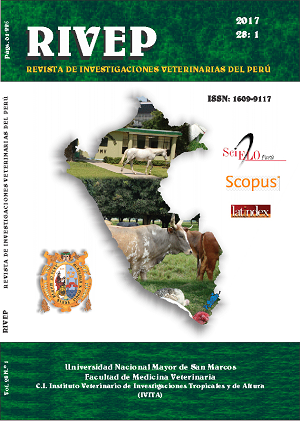Cryotolerance of stallion semen frozen with additives in the extender
DOI:
https://doi.org/10.15381/rivep.v28i1.12944Keywords:
extender, cryopreservation, carbonates, phosphates, quercetinAbstract
Extenders have been established as an alternative to compensate the antioxidant deficiencies of stallion semen during freezing. Several research works have aimed to evaluate the effect of various additives with antioxidant properties on the equine sperm cryotolerance; however, in limited occasions this has been linked with the extender total antioxidant capacity (TAC). This research aimed to evaluate the effect of two additives on freezing extender TAC and stallion semen cryotolerance. Semen of five Colombian Creole horses was frozen in an extender under three treatments: T0: control, T1: quercetin 100 μM, T2: phosphates and carbonates (Na2HPO4 0.32 mg/ml + KH2PO4 0.67 mg/ml + K2CO3 0.39 mg/ml). TAC of extender was evaluated by the ABTS test. Post-thaw motility and kinetics, abnormal morphology (AM), and structural (MSI) and functional (HOS) plasma membrane integrity were assessed. The results were analysed using mixed models. TAC values (μmol trolox/l) for T0, T1 and T2 of 10890 ± 210, 14260 ± 410 and 14670 ± 410 were found. The T2 had higher values for most parameters of motility and membrane integrity (p<0.05). It is concluded that the addition of phosphates and carbonates increases the freezing extender TAC and improves stallion semen cryotolerance.
Downloads
Downloads
Published
Issue
Section
License
Copyright (c) 2017 Juan Esteban Duque C., Benjamín A. Rojano, Giovanni Restrepo B.

This work is licensed under a Creative Commons Attribution-NonCommercial-ShareAlike 4.0 International License.
AUTHORS RETAIN THEIR RIGHTS:
a. Authors retain their trade mark rights and patent, and also on any process or procedure described in the article.
b. Authors retain their right to share, copy, distribute, perform and publicly communicate their article (eg, to place their article in an institutional repository or publish it in a book), with an acknowledgment of its initial publication in the Revista de Investigaciones Veterinarias del Perú (RIVEP).
c. Authors retain theirs right to make a subsequent publication of their work, to use the article or any part thereof (eg a compilation of his papers, lecture notes, thesis, or a book), always indicating the source of publication (the originator of the work, journal, volume, number and date).










